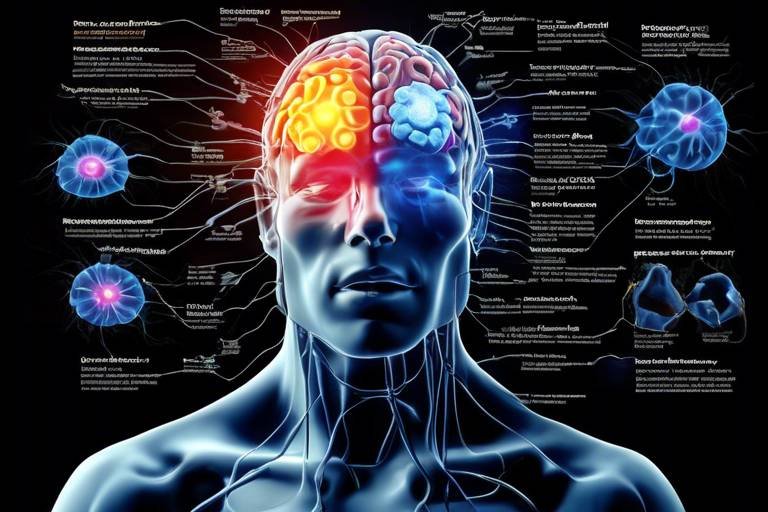The Biology of Mental Resilience - Building Strength
Mental resilience is a fascinating topic that dives deep into the very essence of how we cope with life's challenges. Imagine life as a rollercoaster, with its ups and downs, twists and turns; mental resilience is the safety harness that keeps us secure, allowing us to enjoy the ride despite its unpredictability. It’s not just about bouncing back from setbacks; it’s about thriving in the face of adversity. In this article, we’ll explore the biological foundations of mental resilience, examining how our bodies and brains work together to help us navigate stress and build emotional strength.
At its core, mental resilience refers to the ability to adapt to challenges and recover from setbacks. Think of it as an inner strength that enables individuals to withstand pressure and emerge stronger. This capacity is crucial in our daily lives, influencing how we manage stress, face difficulties, and pursue our goals. Whether it’s dealing with a tough day at work or overcoming personal hardships, mental resilience plays a pivotal role in maintaining our overall well-being. It’s like having a mental toolbox filled with strategies and skills that we can draw upon when times get tough.
Understanding the biological underpinnings of mental resilience allows us to appreciate the intricate ways our bodies respond to stress. The interplay of genetics, neurotransmitters, and environmental factors creates a unique landscape for each individual. For instance, neurotransmitters such as serotonin and dopamine are like chemical messengers in our brains, influencing our mood and emotional health. When we experience stress, these neurotransmitters come into play, helping us navigate our feelings and reactions. It’s a remarkable process that underscores the connection between our biology and our emotional resilience.
In the following sections, we will dive deeper into the various aspects that contribute to mental resilience. We’ll explore the role of neurotransmitters, the impact of stress responses, and the genetic influences that shape our coping abilities. Furthermore, we’ll discuss how environmental factors, such as social support and life experiences, can either bolster or hinder our resilience. By understanding these elements, we can better equip ourselves to cultivate mental strength and navigate the challenges life throws our way.
- What is mental resilience?
Mental resilience is the ability to adapt to challenges and bounce back from setbacks, allowing individuals to maintain emotional stability and well-being.
- How do neurotransmitters affect mental resilience?
Neurotransmitters like serotonin and dopamine regulate mood and stress responses, playing a crucial role in how we handle adversity.
- Can resilience be developed?
Yes, resilience can be developed through adaptive coping strategies, social support, and creating a supportive environment.
- What role does genetics play in resilience?
Genetics can influence an individual's predisposition to cope with stress and adversity, impacting overall mental resilience.

Mental resilience is often described as the ability to adapt to challenges and bounce back from setbacks. But what does that really mean? Imagine life as a rollercoaster ride, filled with unexpected twists and turns. Some people grip the safety bar tightly, feeling every dip and rise, while others throw their hands up, embracing the thrill of the ride. This analogy perfectly encapsulates the essence of mental resilience. It’s the capacity to navigate through life’s inevitable ups and downs with a sense of strength and poise.
At its core, mental resilience is not just about enduring tough times—it's about thriving despite them. It allows individuals to maintain a positive outlook even when faced with adversity. This ability is crucial in our daily lives, influencing how we handle stress, make decisions, and interact with others. For instance, consider someone who loses their job. A resilient person might view this setback as an opportunity for growth, perhaps leading them to discover a new career path or pursue a passion they had previously set aside. In contrast, someone lacking resilience might dwell on the loss, leading to feelings of hopelessness and despair.
Research shows that mental resilience is linked to various psychological and physiological factors. It’s not merely an innate trait; rather, it can be developed over time through experiences and learned behaviors. Factors such as emotional regulation, social support, and a growth mindset all play vital roles in enhancing resilience. By understanding these components, individuals can work towards strengthening their mental fortitude.
Moreover, mental resilience is a dynamic process. It’s influenced by both internal and external factors, making it unique to each individual. Some might find strength in their social networks, while others might draw from personal experiences or spiritual beliefs. This variability is what makes resilience such a fascinating topic of study. It’s not a one-size-fits-all solution; it’s about finding what works best for you and your circumstances.
In summary, understanding mental resilience is about recognizing its significance in our lives. It’s not just about bouncing back; it’s about growing stronger and more adaptable in the face of challenges. As we delve deeper into the biological underpinnings and the various factors that contribute to resilience, we’ll uncover ways to cultivate this essential quality within ourselves. So, let’s keep exploring this exciting journey of mental strength!
- What is mental resilience? Mental resilience is the ability to adapt to challenges and bounce back from setbacks.
- Can resilience be developed? Yes, resilience can be developed over time through experiences, learned behaviors, and support systems.
- What factors influence mental resilience? Emotional regulation, social support, and a growth mindset are key factors influencing mental resilience.

When we talk about mental resilience, we can't overlook the fascinating world of neurotransmitters. These tiny chemical messengers play a pivotal role in how our brain communicates, influencing everything from our mood to our stress responses. Imagine neurotransmitters as the conductors of an orchestra, ensuring that every section plays in harmony. Without them, the symphony of our emotions would be chaotic and dissonant.
Among the most crucial neurotransmitters involved in mental resilience are serotonin and dopamine. Serotonin is often dubbed the "feel-good" neurotransmitter because it helps regulate mood, sleep, and appetite. A deficiency in serotonin can lead to feelings of anxiety and depression, which can severely impact an individual's ability to cope with stress. On the other hand, dopamine is associated with the brain's reward system, playing a significant role in motivation and pleasure. When we achieve something rewarding, dopamine is released, reinforcing our behavior and encouraging us to strive for more. This cycle is crucial for building resilience, as it helps us stay motivated during challenging times.
Understanding how our body responds to stress is essential for grasping the role of neurotransmitters in resilience. When faced with a stressful situation, our body activates the hypothalamic-pituitary-adrenal (HPA) axis. This complex network triggers the release of stress hormones like cortisol, preparing us to either fight or flee. However, this response is not just about survival; it also involves neurotransmitters. For instance, during stress, serotonin levels can dip, leading to mood disturbances. Conversely, effective stress management can help maintain a healthy balance of these neurotransmitters, fostering resilience.
Chronic stress can wreak havoc on our mental health, and its impact on neurotransmitters is particularly concerning. Prolonged exposure to stress can lead to a decrease in serotonin production, which may result in depression and anxiety disorders. Additionally, chronic stress can alter dopamine levels, affecting motivation and pleasure. This creates a vicious cycle where the lack of resilience leads to increased stress, further depleting these essential neurotransmitters. It's a bit like a car running on empty; without proper fuel, it simply can't function well.
The good news is that there are effective coping strategies that can enhance resilience by positively influencing neurotransmitter levels. Engaging in regular physical activity, practicing mindfulness, and maintaining a balanced diet rich in nutrients can all help boost serotonin and dopamine. For instance, foods high in omega-3 fatty acids, such as salmon and walnuts, have been shown to support brain health and improve mood. Furthermore, activities like yoga and meditation can reduce stress and promote a healthier balance of neurotransmitters, empowering individuals to better navigate life's challenges.
In summary, neurotransmitters are the unsung heroes of mental resilience. By understanding their roles and how they interact with our stress responses, we can take proactive steps to enhance our emotional health. Whether through lifestyle changes or seeking support, fostering a healthy balance of these neurotransmitters can significantly improve our ability to cope with adversity.
- What are neurotransmitters?
Neurotransmitters are chemical messengers that transmit signals in the brain, influencing mood, emotion, and behavior. - How do neurotransmitters affect mental resilience?
Neurotransmitters like serotonin and dopamine play a crucial role in regulating mood and stress responses, which are essential for mental resilience. - Can lifestyle changes improve neurotransmitter balance?
Yes! Regular exercise, a balanced diet, and mindfulness practices can help boost neurotransmitter levels and enhance mental resilience.

When we talk about stress response mechanisms, we're diving into a fascinating world of biology that showcases how our bodies react to stressors. Imagine your body as a finely tuned machine, designed to protect you from danger. When faced with a threat, whether it's a looming deadline or a sudden scare, your body kicks into high gear. This response is primarily governed by the hypothalamic-pituitary-adrenal (HPA) axis, a complex network that orchestrates your body's reaction to stress.
The HPA axis is like the conductor of an orchestra, coordinating various elements to produce a harmonious response. It begins with the hypothalamus, which releases corticotropin-releasing hormone (CRH). This hormone signals the pituitary gland to release adrenocorticotropic hormone (ACTH), which in turn prompts the adrenal glands to produce cortisol—the body's primary stress hormone. Cortisol plays a crucial role in managing how we respond to stress by:
- Increasing blood sugar levels for immediate energy.
- Enhancing brain function to improve focus and decision-making.
- Modulating immune responses to prioritize essential functions.
However, while the stress response can be beneficial in short bursts, it can become problematic when activated too frequently. Think of it like a fire alarm that goes off every time someone walks by; eventually, people become desensitized to the alarm, and it loses its effectiveness. Similarly, chronic activation of the HPA axis can lead to a state of persistent stress, which may contribute to various health issues, including anxiety, depression, and cardiovascular problems.
Moreover, our bodies also produce neurotransmitters during stress, which influence our mood and emotional responses. For instance, the release of adrenaline prepares us for a "fight or flight" response, heightening our senses and readiness to act. This is an evolutionary mechanism that has kept humans safe for centuries, allowing us to react swiftly to threats.
In addition to these physiological responses, it's essential to recognize the role of individual differences. Not everyone reacts to stress in the same way, and this variance can be attributed to several factors, including genetics, past experiences, and even personality traits. For example, some people may find that they thrive under pressure, while others may feel overwhelmed and struggle to cope.
Understanding these mechanisms is vital for developing effective strategies to enhance mental resilience. By recognizing how our bodies respond to stress, we can learn to manage our reactions better and cultivate healthier coping mechanisms. It's like learning to ride a bike; once you understand how to balance and steer, you can navigate through both smooth paths and bumpy roads with greater ease.
Q: What is the HPA axis, and why is it important?
A: The HPA axis is a critical part of the body's stress response system. It regulates the release of stress hormones, helping us react appropriately to stressors. A well-functioning HPA axis is essential for maintaining mental and physical health.
Q: How can I manage my stress response?
A: Effective stress management techniques include practicing mindfulness, engaging in regular physical activity, maintaining a healthy diet, and seeking social support. These strategies can help regulate the HPA axis and promote resilience.
Q: Can chronic stress affect my mental health?
A: Yes, chronic stress can lead to various mental health issues, including anxiety and depression. It's crucial to recognize the signs of chronic stress and seek help if needed.

Chronic stress is like an uninvited guest that overstays its welcome, bringing along a host of problems that can wreak havoc on both the mind and body. When we experience stress, our bodies enter a heightened state of alertness, triggering the release of stress hormones like cortisol. While this response can be beneficial in short bursts—think of it as a turbo boost during a race—prolonged exposure to stress can lead to serious consequences. Imagine driving a car at full throttle for hours on end; eventually, the engine will overheat, and the vehicle will break down.
One of the most significant impacts of chronic stress is on our mental health. It can lead to conditions such as anxiety, depression, and even post-traumatic stress disorder (PTSD). The constant barrage of stress can alter brain function, particularly in areas responsible for emotional regulation and memory. Studies have shown that individuals experiencing chronic stress often exhibit changes in their brain structure, including a reduction in the size of the hippocampus, which is crucial for learning and memory.
Moreover, chronic stress can also manifest physically. The connection between mind and body is profound; when one suffers, the other often does too. People under chronic stress may experience headaches, digestive issues, and even cardiovascular problems. Here’s a quick look at some of the physical effects:
| Physical Effects of Chronic Stress | Description |
|---|---|
| Headaches | Frequent tension headaches or migraines can occur due to muscle tension and stress. |
| Digestive Issues | Stress can lead to stomach problems like irritable bowel syndrome (IBS) and ulcers. |
| Cardiovascular Problems | Chronic stress is linked to high blood pressure, heart disease, and stroke. |
| Sleep Disorders | Insomnia and other sleep-related issues often arise from stress, impacting overall health. |
But it’s not just the immediate effects we need to worry about. Over time, chronic stress can lead to a breakdown of resilience, making it harder to cope with future challenges. It’s like a snowball effect; the more stress you endure, the less equipped you become to handle new stressors. This can create a vicious cycle where stress leads to poor coping mechanisms—like substance abuse or withdrawal from social interactions—further exacerbating the problem.
To combat the effects of chronic stress, it’s essential to recognize the signs early and take proactive measures. Engaging in regular physical activity, practicing mindfulness, and seeking social support can all contribute to reducing stress levels. Just as a plant needs water and sunlight to thrive, our mental health requires nurturing and care to flourish. By understanding the detrimental effects of chronic stress, we can take steps to mitigate its impact and build a more resilient mindset.
- What are the common signs of chronic stress? Common signs include fatigue, irritability, difficulty concentrating, and physical symptoms like headaches or stomach issues.
- How can I manage chronic stress effectively? Techniques such as mindfulness meditation, regular exercise, and talking to a therapist can help manage stress levels.
- Can chronic stress affect my relationships? Yes, chronic stress can lead to withdrawal from social interactions and strain relationships due to irritability and mood swings.
- Is it possible to recover from the effects of chronic stress? Absolutely! With the right support and coping strategies, individuals can recover and build resilience.

When life throws challenges our way, how we respond can make all the difference. Adaptive coping strategies are like a toolkit for our mental health, helping us navigate through tough times with grace and strength. These strategies are not just about putting on a brave face; they involve actively engaging with our emotions and circumstances to foster resilience. Think of them as the mental gym where we build our psychological muscles!
One of the most effective adaptive coping strategies is problem-solving. When faced with a challenge, instead of feeling overwhelmed, we can break the situation down into manageable parts. It's like tackling a giant puzzle; instead of staring at the whole picture, we focus on fitting together one piece at a time. This method not only reduces anxiety but also empowers us to take action, giving us a sense of control.
Another vital strategy is mindfulness. Practicing mindfulness involves being present in the moment, acknowledging our thoughts and feelings without judgment. Imagine standing on the shore, watching the waves come and go. Mindfulness allows us to observe our emotions like those waves, understanding that they are temporary and won’t wash us away. Techniques such as meditation, deep breathing, and yoga can enhance our mindfulness practice, helping us to ground ourselves during turbulent times.
Social support also plays a crucial role in our coping arsenal. Engaging with friends, family, or support groups can provide a sense of belonging and understanding. Sharing our struggles with others can lighten the emotional load, making it easier to cope. It's like having a safety net; knowing that someone is there to catch us when we fall can significantly bolster our resilience.
Furthermore, maintaining a healthy lifestyle contributes to our ability to cope. Regular exercise, a balanced diet, and adequate sleep are foundational to mental well-being. These elements work together to enhance our mood and energy levels, making it easier to face challenges head-on. For instance, when we engage in physical activity, our bodies release endorphins, those delightful chemicals that boost our mood and reduce stress. Think of it as a natural antidote to the pressures of life!
Incorporating these adaptive coping strategies into our daily routines can pave the way for a more resilient mindset. Here’s a quick overview of some effective strategies:
| Strategy | Description |
|---|---|
| Problem-Solving | Breaking down challenges into smaller, manageable tasks. |
| Mindfulness | Practicing present-moment awareness without judgment. |
| Social Support | Engaging with friends, family, and community for emotional support. |
| Healthy Lifestyle | Maintaining a balanced diet, regular exercise, and adequate sleep. |
By employing these strategies, we can cultivate a more resilient mindset that enables us to face life's inevitable ups and downs with confidence. Remember, resilience is not a trait we either have or don’t have; it’s a skill we can develop over time. So, let’s get to work on building our mental strength!
- What are adaptive coping strategies? Adaptive coping strategies are methods that help individuals manage stress and challenges effectively, promoting resilience and emotional well-being.
- How can I develop my coping strategies? You can develop coping strategies by practicing problem-solving, mindfulness, seeking social support, and maintaining a healthy lifestyle.
- Why is social support important for resilience? Social support provides emotional comfort, reduces feelings of isolation, and helps individuals cope better with stress.
- Can anyone become more resilient? Yes! Resilience is a skill that can be cultivated through practice and the use of effective coping strategies.

When we think about resilience, it’s easy to attribute it solely to our environment or personal experiences. However, genetics plays a significant role in shaping our ability to cope with adversity. Just like some people are naturally predisposed to be tall or have curly hair, others may inherit traits that make them more resilient to life’s challenges. This genetic influence can be thought of as the foundation upon which our resilience is built.
Research indicates that certain genes are linked to our emotional responses and stress management capabilities. For instance, variations in genes related to the production of neurotransmitters like serotonin and dopamine can affect how we react to stress. Individuals with favorable gene variants may find it easier to maintain a positive outlook and recover from setbacks. This doesn’t mean that resilience is solely determined by our DNA; rather, it’s a complex interplay between our genes and the environment we navigate.
To illustrate this, consider the following key genetic factors:
- 5-HTTLPR Gene: This gene influences serotonin transport in the brain, affecting mood regulation. Individuals with the short variant may experience heightened sensitivity to stress.
- BDNF Gene: Brain-Derived Neurotrophic Factor (BDNF) is crucial for neuron health and plasticity. Variations in this gene can impact learning and memory, which are essential for developing coping strategies.
- COMT Gene: This gene is involved in the breakdown of dopamine. Variants can lead to differences in cognitive flexibility and emotional regulation, which are vital for resilience.
These genetic components highlight how our biological makeup can influence our psychological resilience. However, it’s important to remember that genetics is just one piece of the puzzle. Environmental factors, such as social support and life experiences, interact with our genetic predispositions to shape our resilience. Think of it like baking a cake: while the ingredients (genes) are essential, the way you mix them and the conditions in which you bake (environment) ultimately determine the final product.
Moreover, understanding these genetic influences can empower individuals. By recognizing that certain traits may be inherited, people can focus on cultivating their strengths and seeking support where needed. It’s like having a map that shows your unique pathways; you can navigate life’s challenges more effectively when you understand your starting point.
In conclusion, while our genes can set the stage for resilience, it’s our choices, experiences, and the support we receive that ultimately define our ability to bounce back from adversity. Embracing both the biological and environmental aspects of resilience can lead to a more comprehensive approach to mental health and well-being.
1. Can resilience be developed over time?
Absolutely! While some people may have a genetic predisposition to resilience, it can be cultivated through experiences, coping strategies, and support systems.
2. Are there specific activities that can enhance resilience?
Yes! Activities such as mindfulness, physical exercise, and building strong relationships can significantly enhance your resilience.
3. How does social support affect resilience?
Social support provides emotional comfort and practical assistance, which can bolster an individual’s ability to cope with stress and adversity.
4. Is resilience the same for everyone?
No, resilience varies from person to person, influenced by genetic, environmental, and personal factors.

When we talk about mental resilience, it’s essential to consider the environmental factors that shape our ability to cope with life's challenges. Think of resilience as a tree—its strength doesn't just come from its trunk but also from the soil, water, and sunlight it receives. Similarly, our surroundings play a pivotal role in how we develop emotional and psychological strength. Factors such as social support, socioeconomic status, and life experiences significantly influence our resilience levels.
First and foremost, social support is like a safety net. When we encounter difficulties, having friends, family, or a community to lean on can make all the difference. Studies have shown that individuals with strong social networks are better equipped to handle stress and recover from setbacks. It's no surprise that people who feel connected to others often report higher levels of happiness and lower levels of anxiety. The emotional support provided by friends and loved ones fosters a sense of belonging, which can be incredibly empowering during tough times.
Another critical aspect is socioeconomic status. The environment we grow up in often dictates the resources and opportunities available to us. For instance, individuals from lower socioeconomic backgrounds may face more significant challenges, such as limited access to healthcare, education, and stable housing. These factors can create a cycle of stress that diminishes resilience. However, it’s important to note that resilience is not solely determined by one’s background; many people rise above their circumstances and develop remarkable strength through adversity.
Life experiences also shape our resilience. Each challenge we face can either strengthen or weaken our ability to cope. For example, someone who has navigated through a traumatic event may emerge with a heightened sense of empathy and understanding for others in similar situations. On the flip side, repeated exposure to adverse experiences without adequate support can lead to feelings of helplessness and despair. Therefore, it’s crucial to recognize that while not all experiences are positive, they can contribute to our overall mental fortitude.
To illustrate the interplay of these factors, consider the following table:
| Factor | Impact on Resilience |
|---|---|
| Social Support | Provides emotional and practical assistance, enhancing coping abilities. |
| Socioeconomic Status | Affects access to resources, impacting stress levels and opportunities. |
| Life Experiences | Shapes coping mechanisms and emotional responses to adversity. |
In conclusion, understanding the environmental factors that influence mental resilience is crucial for both individuals and communities. By fostering supportive social networks, addressing socioeconomic disparities, and providing resources to help individuals navigate their life experiences, we can create a more resilient society. Just like a garden flourishes with the right conditions, so too can our mental strength thrive when nurtured by our environment.
- What is mental resilience? Mental resilience is the ability to adapt to challenges and bounce back from setbacks.
- How does social support affect resilience? Strong social connections provide emotional support, which enhances coping abilities during stressful times.
- Can socioeconomic status impact mental resilience? Yes, lower socioeconomic status can limit access to resources, which may affect an individual's ability to cope with stress.
- Are life experiences important for building resilience? Absolutely! Life experiences shape our coping mechanisms and can either strengthen or weaken our resilience.

Social support is like the safety net in the circus of life. When we’re walking the tightrope of challenges, having a solid support system is crucial to maintaining balance and preventing falls. It’s not just a nice-to-have; it’s a must-have! Research consistently shows that individuals with strong social connections tend to experience better mental health outcomes. But why is this the case? Well, let’s dive deeper into the impact of social support on mental resilience.
First off, think about those moments when you’ve faced adversity. Whether it’s a personal loss, job stress, or health issues, having someone to talk to can make all the difference. Social support can take many forms: emotional support from friends and family, informational support through advice and resources, or even tangible support like helping out with daily tasks. Each type plays a role in how we cope with stress and bounce back from setbacks.
One fascinating aspect of social support is its ability to buffer stress. When we encounter stressful situations, our bodies release stress hormones like cortisol. However, studies show that individuals with strong social ties tend to have lower levels of these hormones. It’s as if their friends and family are like a shield against the storm of stress. This buffering effect can lead to improved emotional regulation, helping individuals to maintain a clearer perspective during tough times.
Moreover, social support can enhance our self-esteem and sense of belonging. When we feel valued and understood, it boosts our confidence and encourages us to take on challenges rather than shrink away from them. This is particularly important in today’s fast-paced world, where feelings of isolation can be all too common. For instance, participating in community groups or online forums can foster connections that reinforce our resilience.
To illustrate the impact of social support further, consider the following table that highlights various types of social support and their benefits:
| Type of Support | Description | Benefits |
|---|---|---|
| Emotional Support | Comfort, empathy, and care from others | Reduces feelings of loneliness, enhances emotional well-being |
| Informational Support | Advice, guidance, and knowledge sharing | Helps in decision-making, provides coping strategies |
| Tangible Support | Physical assistance or resources | Alleviates stress, provides practical help during crises |
It’s important to note that the quality of social support matters just as much as the quantity. Having a few close, trustworthy friends often outweighs having numerous acquaintances. In fact, the depth of the relationship can determine how effective the support is. Genuine, empathetic interactions foster a sense of trust and safety, allowing individuals to open up about their challenges without fear of judgment.
So, how can we cultivate social support? It starts with being proactive. Reach out to friends and family, join community groups, or participate in activities that interest you. Building these connections takes time and effort, but the rewards in terms of enhanced resilience and mental health are well worth it. Remember, we’re all in this together, and the stronger our connections, the more resilient we become!

Creating resilient environments is not just about physical spaces; it's about fostering a culture that nurtures mental well-being and emotional strength. Imagine a garden where each plant thrives not just on sunlight and water, but also on the support of its neighboring plants. In the same way, individuals flourish in environments where they feel supported, understood, and valued. So, how can we cultivate such environments? It starts with awareness and intention.
First and foremost, communication plays a pivotal role. Open dialogue within families, workplaces, and communities can help individuals express their feelings and challenges without fear of judgment. When people feel heard, it empowers them to confront their struggles head-on. This can be achieved through regular check-ins, whether it's a simple "How are you doing?" or more structured discussions that allow for deeper sharing. Consider implementing weekly family meetings or team huddles to create a space for sharing and support.
Another crucial aspect is social support networks. These networks can be formal, such as support groups and counseling services, or informal, like friendships and community ties. A strong support network can buffer the effects of stress and adversity. For instance, when someone faces a tough situation, having friends or family to turn to can make all the difference. It's like having a safety net that catches you when you stumble. Building these networks can involve community events, workshops, or even social media groups where individuals can connect and share their experiences.
Moreover, promoting mental health education is essential in creating resilient environments. Educating individuals about mental health, stress management, and coping strategies can empower them to take charge of their well-being. Schools, workplaces, and community centers can offer workshops and resources that teach these vital skills. A well-informed community is better equipped to handle life's challenges, leading to a more resilient population.
Lastly, we must not overlook the significance of physical environments. Spaces that are safe, welcoming, and conducive to well-being can have a profound impact on mental health. This can mean creating green spaces, ensuring access to recreational activities, or simply making sure that homes and workplaces are comfortable and inviting. A cluttered, chaotic environment can lead to increased stress, while a calm, organized space can promote peace of mind. Consider how you can improve your surroundings—maybe by adding plants, reducing noise, or creating quiet zones for relaxation.
In conclusion, creating resilient environments is a multifaceted endeavor that requires collective effort. By fostering open communication, building strong support networks, promoting mental health education, and enhancing physical spaces, we can cultivate an atmosphere where individuals not only survive but thrive. After all, just like a well-tended garden, a resilient community can weather any storm and emerge even stronger.
- What is a resilient environment?
A resilient environment is one that supports individuals in managing stress and adversity through strong social networks, open communication, and a positive physical space. - How can I create a resilient environment at home?
Encourage open discussions, establish routines for family check-ins, and create a comfortable, organized living space. - What role does social support play in resilience?
Social support provides emotional and practical assistance, helping individuals cope with challenges and reducing feelings of isolation. - Can schools contribute to building resilience?
Absolutely! Schools can implement programs that teach coping strategies, promote mental health awareness, and foster a supportive community among students.
Frequently Asked Questions
- What is mental resilience?
Mental resilience is the ability to adapt to challenges and bounce back from setbacks. It's like having a rubber band that stretches under pressure but returns to its original shape. This adaptability is crucial for maintaining emotional and psychological well-being in our daily lives.
- How do neurotransmitters affect mental resilience?
Neurotransmitters, such as serotonin and dopamine, are essential for regulating mood and stress responses. Think of them as the body's chemical messengers; when they function well, they help us feel balanced and resilient. An imbalance can lead to mood disorders, making it harder to cope with stress.
- What happens to the body during a stress response?
When we encounter stress, our body activates the hypothalamic-pituitary-adrenal (HPA) axis, triggering a cascade of physiological responses. This is like turning on an alarm system in your home; it prepares you to react quickly, but if the alarm is constantly going off, it can lead to burnout and fatigue.
- What are the effects of chronic stress on mental health?
Chronic stress can be detrimental to mental health, impairing resilience and potentially leading to psychological disorders. It's like a leaky faucet; over time, the constant drip can cause significant damage. The longer we experience stress, the more challenging it becomes to manage our emotions and cope with life's challenges.
- What are some effective coping strategies for enhancing resilience?
Adaptive coping strategies include mindfulness, exercise, and seeking social support. These strategies are like tools in a toolbox; having the right ones can help you fix problems and navigate tough times more effectively. Finding what works best for you is key to building resilience.
- Do genetics play a role in mental resilience?
Yes, genetics can influence an individual's capacity to cope with adversity. Some people may be genetically predisposed to be more resilient, while others might find it more challenging. It's like having a head start in a race; some are naturally faster, but everyone can improve with practice and training.
- How do environmental factors affect mental resilience?
Environmental influences, such as social support, socioeconomic status, and life experiences, can significantly impact resilience. Imagine building a house; a strong foundation is essential for it to withstand storms. Similarly, a supportive environment helps individuals develop and maintain mental strength.
- What is the importance of social support in building resilience?
Social support is crucial for resilience as it provides emotional and practical assistance during tough times. Think of it as a safety net; having friends and family to lean on can make all the difference when life gets challenging. Strong relationships foster a sense of belonging and help us navigate stress more effectively.
- How can we create resilient environments?
Creating resilient environments involves fostering supportive relationships, promoting mental well-being, and encouraging open communication. It's like cultivating a garden; with the right care and attention, it can flourish. Communities that prioritize mental health create spaces where individuals can thrive and build resilience together.



















